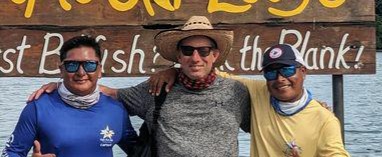Editor’s Note: Dr. Dan Brooks, Curator of Vertebrate Zoology recounts recent adventures off the shores of Panama with local fishermen of the Embera people.

In my last blog, I discussed a recent trip to a remote, pristine part of Panama, just north of the Colombian border. Today I’d like to discuss that trip a little more, focusing on the interaction between the local fishing industry and the indigenous Embera people that are native to the region. The Embera live mostly around the Panamanian Darien and neighboring Colombian Choco,.
The Embera have had a mutualistic relationship with the fishing tourism industry of this region. They are consistently and continuously employed by the fishing lodges. In return their strong, hard work ethic insures the very best experience for foreigners coming to visit to realize their dream of catching big fish.

The fishing lodges start off Embera staff at entry level, portering bags or bussing tables. Once they show aspiration and promise with the visitors, they are promoted. When they reach the fishing operation they might start out cleaning fish and organizing tackle. There are only two positions on each boat – a first mate, and a captain, both jobs require lots of talent. The captain is in charge of course; its his job to not only drive the boat, but more importantly find the fish! The first mate does everything else – getting all tackle ready and casting out once a good fishing spot is found, getting fisherman settled and setting hooks, processing and releasing / cleaning fish as the case may be, etc.
Watching the Embera work on the fishing boats is nothing short of fascinating and amazing (and I do not use amazing lightly!)! I think the DC comic character Aquaman was inspired by someone who was fortunate enough to fish with the Embera! They take the word “sustainable” very seriously, and were probably using every part of the fish before “sustainable” was a popular buzzword. For example, they create lures from the pelivic fins of tuna and mahi, which is much more sustainable than supporting the demand for lures made in factories from plastic and fiberglass. They even save the roe (fish eggs) of the female mahi for later use!




The fishing boat staff even work regularly with non-staffed Embera to insure everyone is benefitting from the presence of the fishing lodges. One example is the mutualistic relationship with Long-liner fishermen… one morning our boat went by a Long-liner in his canoe. Our first mate, Rambo, exchanged pleasantries with him, handed him a lunch, and he in turn handed Rambo some jack fish bait for us to use that he had just caught.
Indeed, the fishing lodges probably could not operate without the presence of the Embera. While the lodges have a presence of 60+ years, the Embera have been there for millenia…
Dr. Dan Brooks is the coordinator of the Houston Urban Wildlife Project. Find out how you can get involved here.






